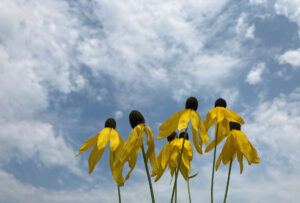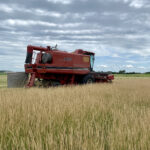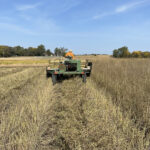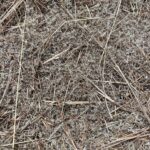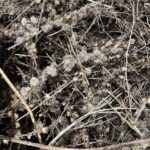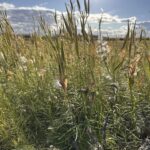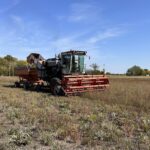By Stephanie Wagner, Site Field & Seed Cleaning Supervisor – The Meadows
Fall is here and it’s even starting to feel a bit wintery! The air is crisp in the morning, the leaves have changed colors, and crews at one of MNL’s production sites, The Meadows, are in the fields harvesting! While harvesting native seed can take place as early as spring, fall is when most of the crops have reached seed maturation.
Before harvest takes place, the seed must be inspected to ensure that it has reached maturity. Some indicators that show mature seed include darkening colors, firmness, opening pods, and fluffy pappus. Indicators of immature seed include green or white in color and will easily collapse when squeezed by a thumbnail. The weather also plays a vital role in determining when or how to harvest seeds. On sunny, dry days, seeds will ripen more rapidly than days that are cold and wet. Strong winds can blow and disperse fluffy seeds and heavy downpours can knock seed loose off stems, both creating a loss in yields.
Depending on the species and location, the method for harvesting native seeds varies between manual and mechanical. Each of MNL’s production locations has their own tricks and methods for harvesting various native species. Manual harvest includes hand stripping or using small hand tools like clippers or sickles. This method allows precise selection on which seed is being harvested, whether it is avoiding weed seeds or collecting only ripe seed. Hand harvesting is often used in locations that produce a variety of different plants like in wetlands or prairies. The faster approach is through mechanical harvesting. This method utilizes a wide range of equipment like modified small grain combines, seed strippers, or windrowers, to harvest singular species in large scale production fields.
A few species, like asters and goldenrods, may require multiple steps to harvest. At The Meadows, the first step for harvesting these species is using a windrower, which cuts the vegetation into long rows of heaped material and exposes it to wind to dry. After a few days of drying, the rows will be harvested by a combine that threshes the material to almost pure seed. Using multi-steps to harvest eliminates the need for further drying and reduces the bulk material and cycles needed in seed cleaning.
Other species are more susceptible to damage during harvest and cannot undergo the threshing cycles in combines. Instead, a modified harvester can be used that cuts the vegetation low to the ground and runs through a conveyor into a wagon, all while keeping the seed heads and stems intact.
Another machine sometimes used for harvest is a flail-vac, which contains a large, cylindrical brush that strips seed into a hopper. This version of harvesting occurs more often with native grasses, but can also be used for forb harvest. This method allows for plots with multiple species to harvest, as it strips the ripe seed and leaves the underdeveloped seed to continue to mature.
To check out some of the various species that MNL produces each year, visit our online store under the “Shop” tab, here: MNLcorp.com/shop

